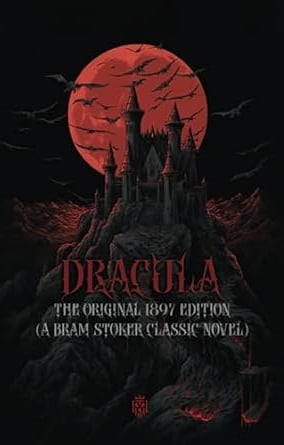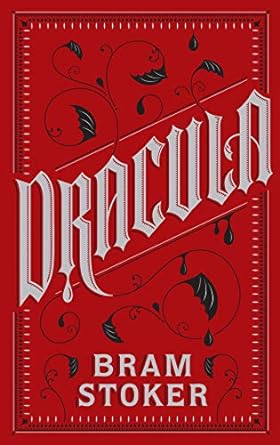Dracula FAQ and Facts
Check out our contents below for answers to popular questions and top facts about Pride and Prejudice. You can also check out more resources here.
Contents
When or what year was Dracula written?
Dracula by Bram Stoker was written over several years in the late 19th century and was first published in 1897.
What genre is Dracula?
Dracula by Bram Stoker falls under the genre of Gothic horror fiction. The novel incorporates elements of romance, suspense, and supernatural terror, which are characteristic of the Gothic genre.
How long is the book Dracula? What’s the word count?
Typically, most editions of Dracula range between 300 and 400 pages long, and the word count for Dracula is approximately 160,000 to 170,000 words.
The page count of Dracula by Bram Stoker can vary depending on the edition, font size, page size, and other formatting factors. The word count might vary slightly based on the specific edition or version of the text in question.
What inspired Bram Stoker to write Dracula?
Bram Stoker's inspiration for Dracula is a subject of much speculation and research, as he left behind few concrete clues about what led him to write the iconic vampire novel. However, there are several factors and influences that might have contributed:
Irish Folklore and Legends: Born in Ireland, Stoker grew up listening to Irish tales and legends, some of which included stories of the undead and creatures similar to vampires.
Historical Figures: The character of Dracula is often linked to the 15th-century Romanian prince Vlad III, known as Vlad the Impaler. While Stoker might have borrowed the name Dracula (a reference to the Order of the Dragon, a chivalric order to which Vlad's father belonged), it's debated how much of Vlad's actual history influenced the character in the novel.
Literary Influences: The vampire myth was not new to literature by Stoker's time. Works like John Polidori's The Vampyre (1819) and Sheridan Le Fanu's Carmilla (1872) might have influenced Stoker's conception of the vampire myth.
Personal Experiences: Some scholars believe Stoker's time as a theater manager, where he met eccentric and captivating personalities, might have contributed to the dramatic and gothic elements of the story.
Victorian Society: Dracula can be seen as a reflection of the anxieties and fears of Victorian society, touching on themes of sexuality, disease (like the syphilis epidemic), and the tension between modernity and tradition.
Travel Accounts: Stoker never visited Eastern Europe, but he researched the region extensively. He read travelogues and other accounts to create a vivid setting for his novel.
Dreams: Some sources suggest that Stoker had a nightmarish dream after a heavy meal of dressed crab, which became the seed for Dracula. Though this account is more anecdotal than factual.
While all these factors might have played a role, it's essential to understand that Dracula is a product of Stoker's imagination, shaped by various influences and his unique interpretation of the vampire myth.
What is Dracula's real name or full name?
In Bram Stoker's novel Dracula, the titular character is simply referred to as Count Dracula.
The name Dracula is derived from the chivalric Order of the Dragon, with which a historical figure, Vlad II, was affiliated. His son, Vlad III (often called Vlad the Impaler), became associated with the name as well, being referred to as "Dracula" meaning "son of the Dragon" (or "son of Dracul").
However, it's important to note that while the name and certain aspects of history might have influenced Stoker, the character of Count Dracula in the novel is fictional and distinct from the historical Vlad III. In the context of the story itself, Count Dracula does not have another "real" or "full" name given; he's primarily known as Count Dracula.
What is the name meaning of Dracula?
In Romanian, "drac" means "dragon." The name "Dracula" can be translated as "son of the dragon" or "son of Dracul."
The name Dracula has its origins in the chivalric Order of the Dragon. Vlad II, the father of Vlad III (commonly known as Vlad the Impaler), was inducted into the Order of the Dragon, a group dedicated to defending Christian Europe against the Ottoman Empire. As a result, Vlad II was often referred to as "Vlad Dracul" or "Vlad the Dragon." His son, Vlad III, then became known as "Dracula," emphasizing his lineage as the son of Vlad Dracul.
While the name has these historical and etymological roots, its association with vampirism, darkness, and horror primarily comes from Bram Stoker's novel, where Dracula is the name of the Transylvanian vampire count.
Are there any nicknames for Dracula?
In Bram Stoker's novel Dracula, the character Count Dracula is primarily referred to by his formal title or simply as "Dracula." There aren't specific nicknames for the character within the text itself.
However, outside of the novel and in popular culture, Count Dracula has been referred to in a variety of ways, often depending on the context or specific adaptation. Some might call him "the Count," "the Vampire Count," or "the Prince of Darkness." Over the years, as Dracula has become an iconic figure in horror, he's been adapted, reinvented, and parodied numerous times, which might give rise to various informal or playful nicknames based on specific contexts or interpretations.
It's also worth noting that the historical figure Vlad the Impaler, often associated with the Dracula legend, had the nickname "Tepes" (pronounced "Tse-pesh"), which means "The Impaler" in Romanian. However, this nickname is specific to the historical figure and not the fictional vampire.
Does Dracula have a wife?
In Bram Stoker's novel Dracula, there is no mention of Count Dracula having a wife. The story primarily focuses on Dracula's pursuit of victims, particularly Mina Harker, and the efforts of a group of individuals to stop him. While the novel provides some background on Dracula's history and his connection to the historical figure Vlad the Impaler, it does not include any information about a wife or romantic partner.
However, there are other adaptations and variations of the Dracula story, both in literature and in popular culture, where Dracula or Dracula-like characters may have wives or romantic interests. These adaptations often take creative liberties with the original story. Here are a few examples:
Bram Stoker's Dracula (1992) Film: In this movie directed by Francis Ford Coppola, Dracula (played by Gary Oldman) is portrayed as a tragic figure. The film incorporates a love story between Dracula and Mina Harker (played by Winona Ryder), suggesting a romantic connection that goes beyond the traditional vampire-human dynamic.
Nosferatu (1922) Film: This silent film adaptation of Dracula, directed by F. W. Murnau, features Count Orlok as the vampire antagonist. While not explicitly Dracula, this character is based on the same source material. In this adaptation, Count Orlok is portrayed as being interested in a character named Ellen Hutter (similar to Mina Harker).
Penny Dreadful TV Series: In the TV series Penny Dreadful, Dracula is portrayed as an important character. While the series deviates from the original novel in many ways, it explores Dracula's relationships, including a romantic connection with another character.
Blade: Trinity (2004) Film: While not directly related to Dracula, this film features a vampire character named Drake (also known as Dracula), who has a daughter named Danica Talos. The family dynamic is an important aspect of the plot.
As for the real-life inspiration for Dracula, Vlad the Impaler (Vlad III), there is historical evidence of his marriages and family life. Vlad III was a 15th-century ruler of Wallachia (now part of modern-day Romania). He is known for his brutal methods of ruling and his association with impalement. Vlad III had multiple wives and children, and some of them played roles in various political alliances of the time.
It's worth noting that while adaptations of the Dracula story often introduce new elements and relationships, they do so for dramatic or narrative purposes and may not reflect the original character created by Bram Stoker.
Support Ai Read to Me
Help us create more audiobooks and release more free content! Shop our store, or purchase anything on Amazon via the book affiliate links below.
We are very grateful for your support!








